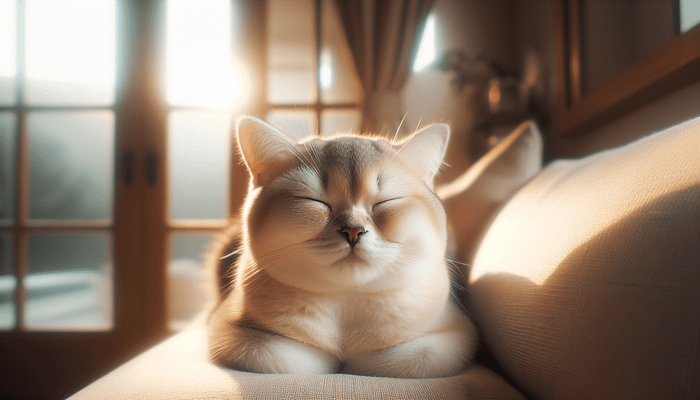What Does It Mean When A Cat Blinks Slowly?
Unlock the mystery of your cat’s slow blink! Dive into how this gesture signifies trust, love, and more. Learn how to reciprocate to strengthen your bond!
What Does It Mean When A Cat Blinks Slowly?
Introduction
I remember the first time my cat, Paws, looked at me and blinked ever so slowly. It was almost as if he was trying to tell me something but couldn’t quite find the words. Was he sleepy? Bored? Angry that I’d moved his favorite scratching post for the third time that month? As someone who values understanding the quirks and behaviors of my feline friend, I embarked on a little journey into the world of slow blinks. Spoiler alert: it’s a lot more interesting than you might think.
The Art of the Slow Blink
Let’s start by breaking down the behavior itself. When Paws blinks slowly, he’s not merely succumbing to fatigue or showing off his expert eyelid control. This slow blink, also known as a “cat kiss,” is actually a form of communication. It’s like the Morse code of the feline world — simple, yet full of meaning.
It’s All About Trust
One of the most common interpretations of a cat’s slow blink is trust. When a cat closes its eyes around you, even temporarily, it’s a vulnerable act. In the wild, keeping one’s eyes wide open protects against potential threats. So, when Paws takes a moment to slow-blink at me, he’s essentially saying, “I trust you enough to let my guard down, human.”
The Love Language of Cats
If trust weren’t heartwarming enough, the slow blink can also indicate affection. Yes, when your cat lazily closes his eyes and reopens them, he’s not just falling asleep — he’s expressing his love. Think of it as the feline equivalent of a gentle, reassuring hug. It’s like when you’re binge-watching your favorite show and your cat curls up next to you, only this time, he’s making direct eye contact and sending you slow-blink kisses.
Non-Threatening Communication
For our feline friends, direct eye contact can sometimes be seen as threatening. In the wild, a prolonged stare can precede a showdown. So, when a cat breaks that stare with a blink, it’s basically waving the white flag and saying, “Hey, I come in peace.” It’s an excellent way of diffusing what could be a tense situation.

How To Respond to a Cat’s Slow Blink
Knowing that a slow blink is a sweet, non-verbal message from your cat, it raises the question: How should you respond?
Return the Gesture
One of the best ways to reply to your cat’s slow blink is to mimic it. Seriously, go ahead and give Tinkerbell a slow, deliberate blink the next time she does it to you. This simple yet profound act can strengthen the bond between you two. It’s like a secret handshake for the feline-human relationship.
Avoid Prolonged Staring
Since we’ve established that prolonged eye contact can be threatening, it’s best to avoid staring right back at your cat. Instead, opt for the slow blink, or soften your gaze to ensure you’re not sending mixed signals.
Speak Softly and Move Gently
When engaging in this slow-blink exchange, consider speaking to your cat in a soft, soothing tone. Combine this with gentle movements to further communicate your friendliness and love. It’s akin to whispering sweet nothings but for the feline kind.
Scientific Studies on Slow Blinking
This isn’t just me making a mountain out of a molehill — or a cat blink, for that matter. There’s actual science behind this behavior that can help decode your cat’s cryptic language.
The University of Sussex Study
In one notable study conducted by researchers at the University of Sussex, scientists observed interactions between cats and humans to examine the slow blink phenomenon. The study found that cats were more likely to slow blink at their owners compared to strangers. Furthermore, when humans slow-blinked at cats, the cats were more inclined to approach them, suggesting mutual trust and affection.
The Blink Paradigm
Another intriguing finding from the Sussex study is what researchers called the “Blink Paradigm.” They discovered that when humans initiate the slow blink, it can serve as a positive reinforcement that encourages cats to engage more socially. So, if you’re eager to increase your cat’s affection toward you, go ahead and master the art of the slow blink.

The Psychology of Cat Behaviors
Understanding slow blinking isn’t just about deciphering an isolated behavior; it fits into a broader understanding of feline psychology.
Body Language
Cats communicate using a complex array of body language, from the way they position their tail to how they arch their back. The slow blink is just one piece of this intricate puzzle. To truly understand your cat, you have to consider their entire behavioral repertoire.
Vocalizations
Besides body language, vocalizations are another key aspect of cat communication. From purrs to meows to hisses, cats have a surprisingly rich vocal vocabulary. While the slow blink is silent, it often accompanies other actions or vocal cues that can offer a fuller picture of what your cat is trying to say.
Environment and Context
It’s important to consider the environment and context when interpreting a slow blink. For example, a slow blink in a peaceful, familiar setting like your living room is likely an affectionate gesture. However, in a noisy or stressful environment, it could serve as a coping mechanism to signal non-aggression.
Practical Applications of Understanding the Slow Blink
So now we get to the fun part: How can this newfound knowledge impact your day-to-day relationship with your cat?
Enhancing Bonding Time
Devoting time to engage in slow-blink exchanges with your cat can significantly enhance your bond. Whether you’re chilling on the couch or lying in bed, take a moment to look into your cat’s eyes and initiate a slow blink. It’s a small gesture that packs a hefty emotional punch.
Reducing Stress and Anxiety
Knowing that slow blinking signifies trust and affection can be especially comforting during stressful times. If you sense that your cat is anxious or scared, offering a slow blink can help reassure them. It’s like telling a friend, “I’m here for you,” but with your eyes.
Improving Training and Interaction
Understanding this behavior can also be beneficial during training sessions. Rewarding your cat with a slow blink after they successfully perform a trick can serve as positive reinforcement. It’s a subtle yet effective way to show your appreciation without overwhelming them with treats or overly energetic praise.
Misinterpretations and Common Myths
As with any form of communication, there’s always a risk of misunderstanding. Let’s dispel some of the common myths surrounding the slow blink.
“My Cat Is Just Tired”
While it’s true that cats often blink slowly when they’re relaxed or sleepy, that’s not the whole story. The intent behind a slow blink is deeply rooted in their social behavior and isn’t merely a sign of fatigue.
“It’s a Sign of Illness”
Some people mistakenly think that slow blinking could indicate an eye issue or illness. While it’s essential to monitor your cat for any signs of health problems, a slow blink on its own is typically a positive behavior rather than a symptom of something wrong.
“All Cats Do It”
Not all cats will exhibit slow blinks, and that’s okay. Each cat is unique, with its own personality and communication style. The absence of slow blinks doesn’t necessarily mean your cat doesn’t trust or love you; they might just express it differently.
How to Encourage Your Cat to Slow Blink
If your feline friend is reluctant to engage in slow-blink exchanges, there are ways to encourage this behavior.
Create a Comfortable Environment
Cats are more likely to express affection when they feel safe and comfortable. Ensure that your home environment is feline-friendly, with cozy spots, scratching posts, and plenty of vertical space.
Engage in Gentle Play
Playing with your cat in a non-aggressive manner can help to build trust and affection. Use toys that mimic prey, like feather wands or laser pointers, to engage your cat in a fun and non-threatening way. After playtime, your cat might be more inclined to offer a slow blink.
Spend Quality Time
Simply spending quality, undisturbed time together can help foster the trust necessary for a cat to feel comfortable slow-blinking at you. Sit with them, read a book, or watch TV. Just being around can work wonders.
The Broader Implications: Cat-Human Relationships
Understanding the slow blink is just one aspect of the broader, fascinating relationship between cats and humans.
Building Mutual Trust
The slow blink is a gentle reminder that building a relationship with your cat takes time and effort. It’s a two-way street where mutual trust and affection are earned, not given.
Emotional Well-being
When your cat trusts and loves you, it’s beneficial not just for them, but for you too. The sense of connection and emotional satisfaction derived from these interactions can improve your mental well-being.
Animal Behavior Studies
Behavioral studies, like those focused on slow blinking, can deepen our understanding of animal intelligence and emotional capacity. By paying attention to these nuances, we gain insight into the complex inner lives of our pets.
Conclusion
So what does it mean when a cat blinks slowly? In short, it’s a multifaceted form of communication that conveys trust, affection, and non-aggression. It’s the feline equivalent of a warm hug, a soft kiss, or a reassuring whisper. Understanding this simple yet profound gesture can significantly enhance the bond you share with your cat.
Next time Paws looks at me and blinks ever so slowly, I’ll know exactly what he’s trying to tell me. And I’ll be sure to blink back, giving him the love and trust he’s shown me.
Enjoyed this deep dive into the enigmatic world of the feline slow blink? Give this article a clap, leave a comment, and consider subscribing to my Medium newsletter for more quirky and heartfelt explorations into the lives of our animal companions. Thanks for reading!
